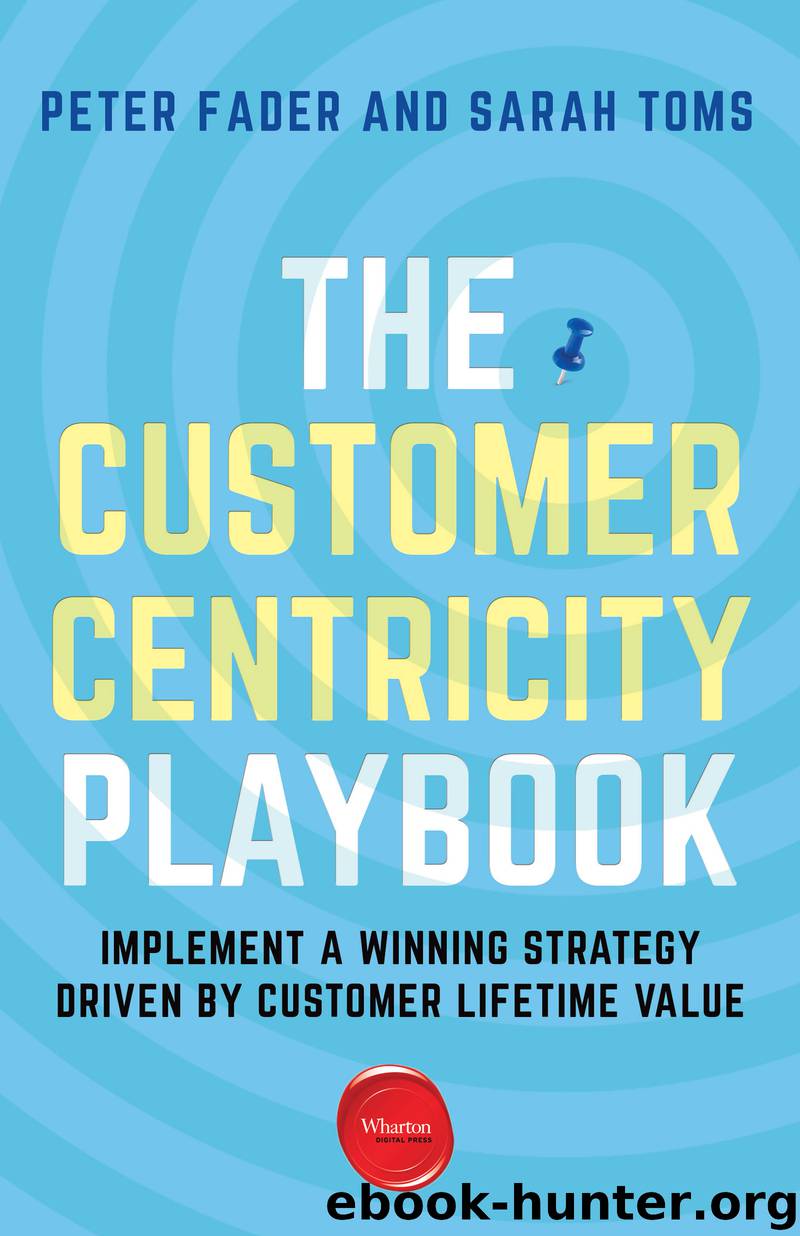The Customer Centricity Playbook by Peter Fader

Author:Peter Fader
Language: eng
Format: epub
Publisher: Wharton Digital Press
Chapter 4
CRM’s Place in Creating a Value-Based Strategy
Customer relationship management (CRM) is essential to any modern business strategy that depends on managing complex interactions with customers—which is to say, pretty much all of them. In the view of major CRM providers, a well-executed CRM system is a technological solution that serves as the nerve center of the business, enabling growth and profitability by helping to make sense of massive amounts of customer data from multiple streams, such as sales, marketing, customer service, and social media.66
Paul Greenberg, author of CRM at the Speed of Light, foresaw decades ago that CRM would eventually connect all business relationships—though he laments to this day that CRM hasn’t advanced beyond a technology platform into an organizational linchpin that incorporates more holistic views, integrating strategy, philosophy, and corporate culture.67 Nevertheless, from the foresight of Greenberg to the astronomical success of Salesforce, the theory behind CRM sounds fabulous. But does a proper CRM system really matter all that much to the bottom line?
In a word, yes. Look no further than the popularity of Ring video doorbells or Nest “learning” thermostats to understand the reasons that now, more than ever, CRM is incredibly relevant. The internet revolution is only just getting warmed up, and it will continue to transform the way customers—both individuals and enterprises—purchase and use goods and services.
Many organizations have been caught off guard by the rapid pace at which the internet has evolved, leaving those that struggle with adjusting to these modern ways in the virtual dust. Web 1.0 gave customers access to predominantly static information, like the Wikipedia-type websites that served as electronic classifieds and online shopping carts that digitized paper-catalog versions produced by the very same companies. Then Web 2.0 came along, transforming the internet experience by, among many other things, bringing hyper-interactivity to social platforms, thereby putting users—not businesses—at the center of web content creation. Currently, we are on the verge of Web 3.0 being fully realized, where the internet will become increasingly shaped by machine learning, artificial intelligence (AI), and the preference algorithms that companies such as Amazon and Netflix introduced in earlier incarnations and continue to perfect. Web 3.0 will be a semantic, artificially intelligent, and deeply personalized web that anticipates the future desires, emotional responses, and predictive behaviors of customers through analysis of everything people do online—and everything people’s things do, including their connected homes, wearable devices, AI personal assistants, smart cars, and smart washing machines. In this emerging reality, everything will be connected via the Internet of Things (IoT).68
Imagine the possibilities for businesses once IOT is fully realized: all the data about a single customer perpetually generated and sent back to companies, all day every day. Imagine how differently customers will make purchases: Will routine purchasing decisions such as the weekly grocery list and monthly prescription reorders be handed off to the IOT? Will customers relinquish even more purchasing control for some of the larger decisions, enabling their refrigerator or mobile phone to decide that it’s time to
Download
This site does not store any files on its server. We only index and link to content provided by other sites. Please contact the content providers to delete copyright contents if any and email us, we'll remove relevant links or contents immediately.
Bad Blood by John Carreyrou(6559)
Rich Dad Poor Dad by Robert T. Kiyosaki(6414)
Principles: Life and Work by Ray Dalio(6234)
Playing to Win_ How Strategy Really Works by A.G. Lafley & Roger L. Martin(5944)
Management Strategies for the Cloud Revolution: How Cloud Computing Is Transforming Business and Why You Can't Afford to Be Left Behind by Charles Babcock(4528)
The Confidence Code by Katty Kay(4192)
Thinking in Bets by Annie Duke(4154)
American Kingpin by Nick Bilton(3761)
Delivering Happiness by Tony Hsieh(3369)
Project Animal Farm: An Accidental Journey into the Secret World of Farming and the Truth About Our Food by Sonia Faruqi(3179)
The Power of Habit by Charles Duhigg(3063)
The Tyranny of Metrics by Jerry Z. Muller(3008)
Brotopia by Emily Chang(3002)
Mastering Bitcoin: Programming the Open Blockchain by Andreas M. Antonopoulos(2985)
The Marketing Plan Handbook: Develop Big-Picture Marketing Plans for Pennies on the Dollar by Robert W. Bly(2978)
I Live in the Future & Here's How It Works by Nick Bilton(2941)
The Content Trap by Bharat Anand(2864)
Building a StoryBrand by Donald Miller(2844)
Applied Empathy by Michael Ventura(2839)
